The semi-arid island of Fuerteventura lies just 52 nautical miles off the coast of Morocco. Geographically closer to Africa than to mainland Spain, Fuerteventura is the second largest Canary Island, just after Tenerife.
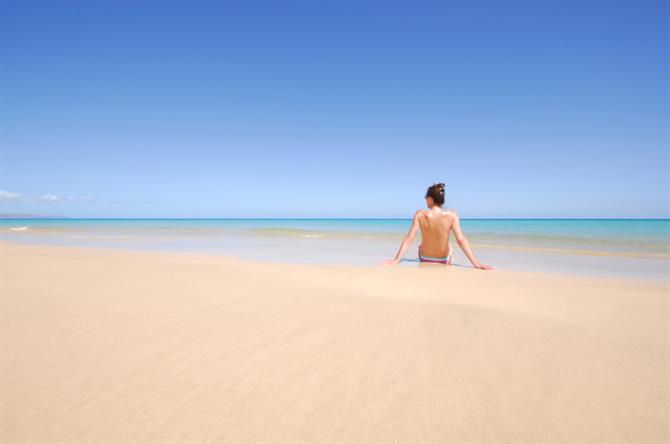
With a near perfect climate, average monthly temperatures ranging from 17°C in January to 25°C in August, over three thousand hours of sunshine a year and less than 150mm of rainfall, Fuerteventura is the winter sun destination. With close to 1.8 million tourists gracing its shores last year. Here is everything you need to know about the island for your stay in one of Fuerteventura's villas.
Fuerteventura’s geography
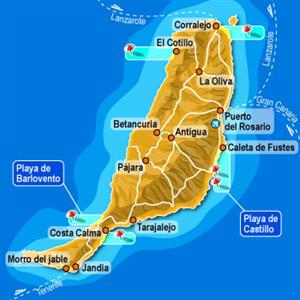 The seven islands that make up the Canary Islands archipelago are Tenerife, Gran Canaria, Lanzarote, Fuerteventura, La Gomera, La Palma and El Hierro. They stretch from east to west in a 500km arch.
The seven islands that make up the Canary Islands archipelago are Tenerife, Gran Canaria, Lanzarote, Fuerteventura, La Gomera, La Palma and El Hierro. They stretch from east to west in a 500km arch.
The island of Fuerteventura is the second-largest and measures 1660km2 (including the island of Los Lobos). Widely believed to the oldest of the Islands, having been the result of a volcanic eruption some 20 million years ago.
The island can be divided up into two sections: la Maxorata and the Jandia Peninsula. Most of the economic activity and nearly all the inhabitants live La Maxorata. The Jandia Peninsula is the arid, mountainous and windswept south.
Its origins and location, less than 100kms from the Sahara have been instrumental in giving Fuerteventura its desert, almost lunar-like landscape. The prevailing easterly winds, blowing in from the Sahara have brought in all the fine white sand that makes up the spectacular beaches and sand dunes that the island is so famous for.
The sand dunes of Corralejo, near one of the most well known and cosmopolitan of the island's resorts, have now been designated a Natural Park, along with the island of Los Lobos.
The waters off the coast are teeming with fish and is said to have some of the best diving and deep-sea fishing in Europe. Dolphins, marlins and whales are common sights.
Beaches in Fuerteventura
Fuerteventura is a prime destination for sun, beach and watersports enthusiasts.
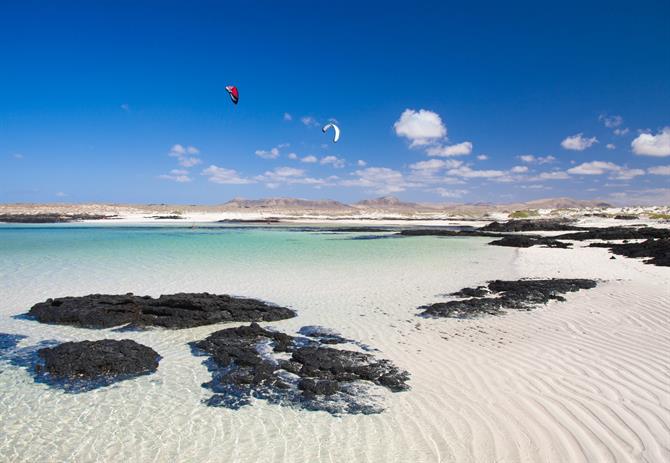
Blessed with the longest beaches in the Canaries and having no less than 152 of them along its 350kms of coastline. It offers every conceivable kind of beach. It is of little surprise that the island was selected for the prestigious Quality Coast International Certification award last year.
From the hardcore windsurfing beaches in the north to the more quieter, secluded ones in the south. The choice is most definitely yours. The choice is also yours, whether or not to keep your kit on. Nudism is widely accepted on the island.
Depending on sea and wind conditions, a good surfing spot one day, is a quiet/family beach, the next. And the island is small enough to drive and find whatever you are looking for in the day.
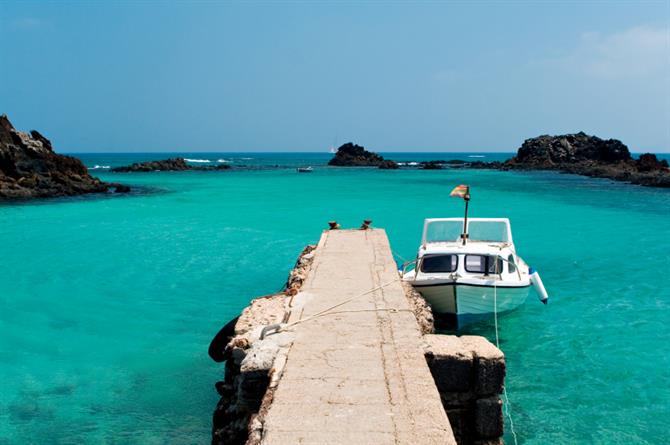
Surfing hotspots include El Cotillo, Sotavento (home to the world kite surfing championships every August), Majanicho, La Caleta, Punta Blanca and Cofete - said to be a great beach for beginners.
The postcard-perfect Corralejo, situated in the north of the island and stretching for six miles of fine golden sand is a firm favourite. And with a good reason.
Looking at the picture below, it's like stepping straight into the pages of a glossy travel magazine.
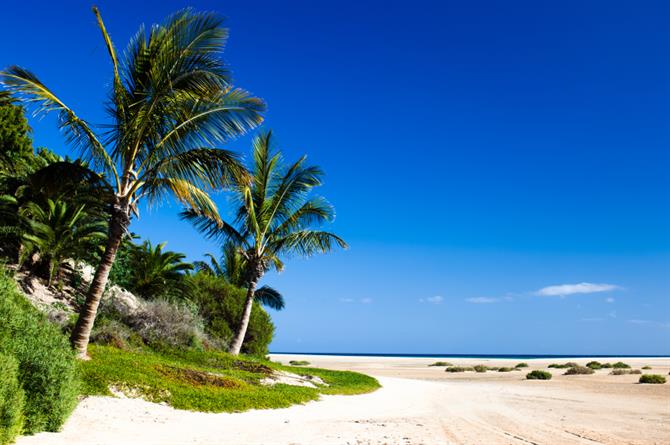
The paradisiacal island of Los Lobos is a mere ten minutes away by ferry from Corralejo.
The carefully protected natural park is said to have the best snorkelling in the area. Combined with a quick walk up the island’s highest peak the Caldera de la Montana (127m), its another must-see when on holiday in Fuerteventura.
Off the beaten track
Fuerteventura isn't all about beaches. The wild, untamed interior of the island offers some fantastic day trips and hidden rural getaways.
The 600-year-old village of Betancuria was once the Fuerteventuran capital and is arguably the most picturesque village on the island. Located on a plain that is situated between volcanic mountains, the bougainvillaea draped whitewash buildings are a joy to behold.
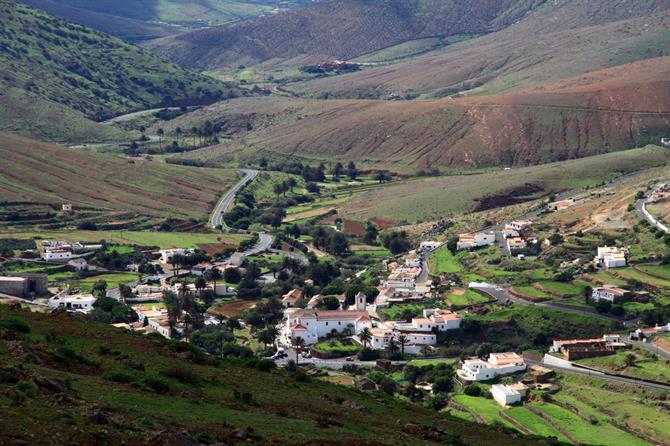
There are numerous other quaint Canarian villages scattered across the island. Places that have stood the test of time and ones that are far removed from the hustle and bustle of the coastal areas.
In the north; Lajares and La Oliva & Villaverde are of note. The centre of the island is home to Antigua, Triquivijate, Tiscamanita & Casillas de Morales. Pájara is another highlight and home to the Jandia natural park.
Goats, windmills and aloe vera
The two most iconic Fuerteventuran motifs have to be goats and windmills. Its hard to believe that the harsh landscape is home to over a quarter million goats. But it is. And they thrive. Unfortunately often at the expense of the surrounding countryside.
Erosion aside, Fuetreventura’s award-winning goat cheese is world-famous and with good reason. Majorero and Palmero cheeses are the ones to keep an eye out for. They are also the only two Canarian kinds of cheese that are protected with a Denominación de Origen.
So ingrained are goats and cheese in Fuerteventurian history, that people are still warm-heartedly known as Majoreros, which comes from the Guanche word 'mahos,' a type of goatskin shoe worn by the original settlers.
A windmill is never far in Fuerteventura. The windswept island has always been ideal windmill country. Some of the older examples dating back over 200 years.
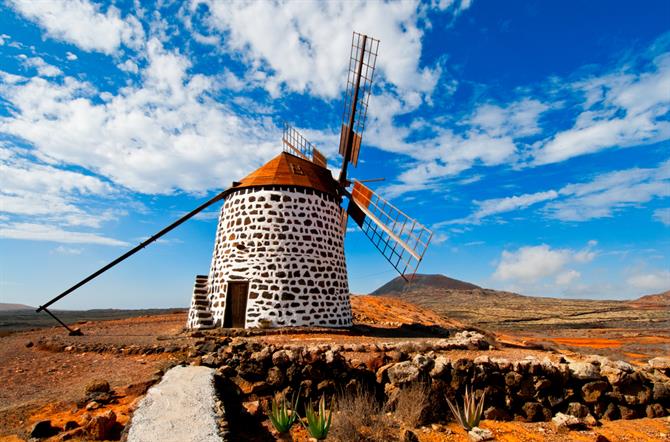
Interestingly, traditional windmills are distinguished by gender. Molinas - the female windmills are one storey high, while their male counterparts - Molinos - are two storeys high. They were originally used for maize grinding to make the much-loved Canarian staple, gofio. The best examples are found near the island’s oldest village, Antigua.
Aloe Vera is just about the only plant that can stand Fuerteventura's harsh climate. It does so very successfully. Aloe Vera and its derivatives now make up an important part of the local economy.
The species of Aloe Vera that thrives locally is the Barbadensis type. The one that is said to have almost magical healing qualities. Even Christopher Columbus was a fan and whilst in the Canaries, he stocked up his vessels with the plant. It is generally accepted that the American plantations are descended from the Canary Islands.
Additional information
For some fantastic holiday rentals in the Canaries and last-minute rental offers.
More reading:
Top 10 beaches on Fuerteventura
Best nudist beaches in the Canaries
The top 3 beaches in Fuerteventura
Ten different scenes of Fuerteventura
